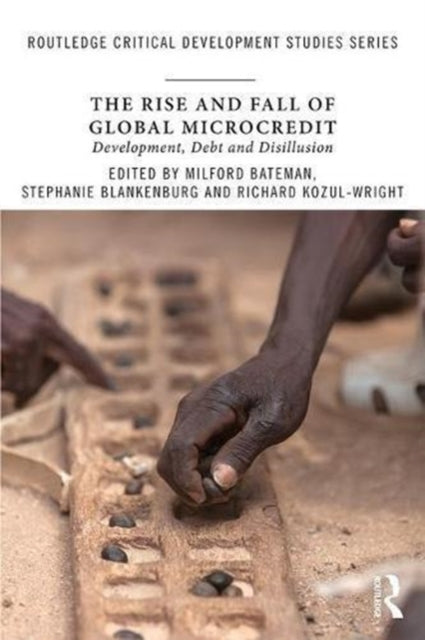
Rise and Fall of Global Microcredit: Development, debt and disillusion
 Limited Time Sale
Limited Time Sale$21.54 cheaper than the new price!!
Free cash-on-delivery fees for purchases over $99
Product details
| Management number | 201823539 | Release Date | 2025/10/08 | List Price | $21.54 | Model Number | 201823539 | ||
|---|---|---|---|---|---|---|---|---|---|
| Category | |||||||||
Microcredit, a popular poverty reduction and local economic development policy, was initially praised but has faced scrutiny and criticism in recent years. This book explores the short- and long-term impacts of microdebt and provides country-specific case studies to illustrate the real dynamics, incentives, and end results. It is a valuable guide for students, academics, policymakers, and development professionals.
Format: Paperback / softback
Length: 290 pages
Publication date: 10 September 2018
Publisher: Taylor & Francis Ltd
In the mid-1980s, the international development community played a pivotal role in launching a policy that would soon gain widespread popularity as a means of reducing poverty and promoting local economic development. Known as microcredit, this system involved the disbursal of small loans to impoverished individuals, with the aim of enabling them to establish their own income-generating activities. Initially, microcredit received widespread praise and was even hailed as a potential solution to eradicate poverty on a global scale. However, in recent years, the microcredit model has come under increasing scrutiny and has faced intense criticism.
The Rise and Fall of Global Microcredit: An Examination of the Short- and Long-Term Impacts of Dramatically Rising Levels of Microdebt is a comprehensive book that delves into the various issues surrounding microcredit. Developed in collaboration with UNCTAD, this book explores the policy implications of adverse microcredit impacts and provides a collection of country-specific case studies to illustrate the real dynamics, incentives, and outcomes of this policy. Written in a lively and provocative style, The Rise and Fall of Global Microcredit is accessible to students, academics, policymakers, and development professionals alike.
One of the central concerns with microcredit is its short-term impact on the lives of the poor. While microloans can provide a temporary boost to individuals and families, they often come with high interest rates and strict repayment terms, making it difficult for borrowers to repay their debts and escape the cycle of poverty. In many cases, borrowers are forced to take on additional debt to meet their repayment obligations, leading to a vicious cycle of debt and financial instability.
Furthermore, microcredit has been criticized for its lack of sustainability and its potential to exacerbate poverty rather than alleviate it. While microcredit programs can provide individuals with the tools and resources they need to start their own businesses, they often fail to address the underlying structural issues that contribute to poverty, such as lack of access to education, healthcare, and basic infrastructure. Without addressing these root causes, microcredit programs may only provide a temporary solution to poverty, rather than a long-term one.
Another issue with microcredit is its impact on women and marginalized communities. Women, who often face greater barriers to accessing financial services, are disproportionately affected by microcredit programs. Studies have shown that women who receive microloans are more likely to use them for household expenses and to support their families, rather than for business development. This can limit their ability to escape poverty and achieve economic independence.
Furthermore, microcredit programs have been criticized for their lack of inclusivity and their potential to perpetuate social and economic inequalities. In many cases, microcredit programs target specific communities or groups, such as rural women or marginalized ethnic minorities, and may exclude others who are in need of financial services. This can create a sense of exclusion and marginalization, which can further exacerbate social and economic disparities.
Despite these criticisms, microcredit remains a popular policy tool among international development organizations and governments. However, it is important to approach microcredit with a critical eye and to ensure that it is implemented in a sustainable and inclusive manner. This requires a comprehensive understanding of the underlying issues that contribute to poverty and a commitment to addressing these root causes through long-term development programs.
In conclusion, The Rise and Fall of Global Microcredit: An Examination of the Short- and Long-Term Impacts of Dramatically Rising Levels of Microdebt is a valuable resource for anyone interested in understanding the complexities of microcredit and its impact on poverty reduction and local economic development. By providing a comprehensive analysis of the short- and long-term impacts of microcredit, this book sheds light on the fundamental problems surrounding this policy and highlights the need for a more sustainable and inclusive approach to addressing poverty. As we continue to grapple with the challenges of global poverty, it is essential that we continue to explore and evaluate the effectiveness of different policies and programs, and that we work towards creating a more equitable and sustainable world for all.
Weight: 472g
Dimension: 236 x 163 x 18 (mm)
ISBN-13: 9781138714120
Correction of product information
If you notice any omissions or errors in the product information on this page, please use the correction request form below.
Correction Request Form
















